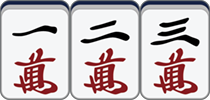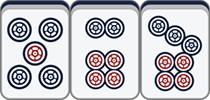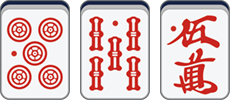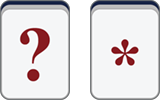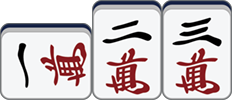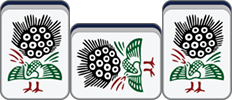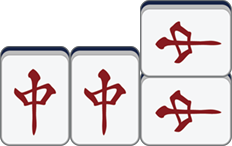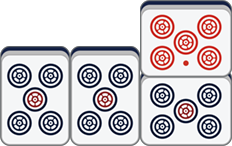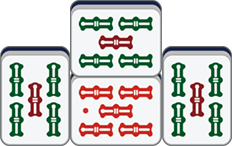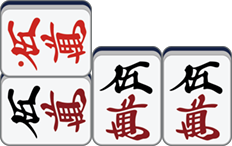mahgen v1.0.0
Mahgen
English | 中文


mahgen is a library that generates tile images for given Japanese mahjong patterns. mahgen is the abbreviation for *Mahjong* *Generator*.
Features
mahgen supports various tile patterns, for example:
- Basic


- Chii

- Pon

- Kan

- Red Dora

You can visit this website which uses mahgen to generate your own tile images online ans save them locally for other uses. For example, the tile images shown above were all generated by the site.
Installation
Use CDN
You can use mahgen directly from a CDN via a script tag:
<script src="https://unpkg.com/mahgen/dist/index.umd.js"></script>You can also download this file and serve it yourself.
Use NPM
You can also use npm and execute:
npm install --save mahgenUsage
mahgen defines a new custom HTML tag called <mah-gen>, including two custom attributes:
data-seqis used to specify the pattern of the tile image generated by the tag.data-show-erris used to specify whether to show error messages when the sequence assigned bydata-seqis invalid.
Below is a simple example of using mahgen:
<!doctype html>
<html lang="en" data-theme="light">
<head>
<meta charset="utf-8">
<meta name="viewport" content="width=device-width, initial-scale=1">
<title>Mahgen Example</title>
<script src="https://unpkg.com/mahgen/dist/index.umd.js"></script>
</head>
<body>
<h1>Mahgen Example</h1>
<mah-gen data-seq="123m|456p" data-show-err></mah-gen>
</body>
</html>You can check this demo to see how it renders.
API
mahgen also provides the following API:
Mahgen.render(seq: string): Promise<string>;Where:
seqis a string used to describe the pattern(we will describe its syntax in the next section);- The return value is the base64 data of the generated image, which can be used in e.g. the
srcattribute of the<img>tag in HTML.
Note that this is an asynchronous function, so you may need await keyword or .then() method to retrieve the result.
If the input sequence is not syntactically correct, the function throws an exception of type ParseError, which can be caught by try...catch statement or .catch() method. ParseError contains the following two members:
code: an enumeration of typeErrorCode, indicating the reason of the error.index: a number indicating the position of the error(0-based).
In fact, custom tag <mah-gen> is just a wrapper on top of this API.
Syntax
Numbered Suits(Pin, So, Man)
In Japanese mahjong, the digits 1-9 are usually used to describe the number of a tile, and the letters p, s, m to describe the suit Pin, So, Man. Therefore, the sequence 1m2m3m would indicate the pattern 1-wan, 2-wan, 3-wan, and 5p6p7p 5-pin, 6-pin, 7-pin.
1m2m3m
5p6p7p
In particular, we use the number 0 to denote a red dora, so 0p, 0s, 0m denote red 5-pin, red 5-so, red 5-wan, respectively:
0p、0s、0m
For tiles of the same suit, You can omit all the letters except for the last one for simplicity. For example, you can simplify 1m2m3m to 123m and 5p6p7p to 567p. You can also write 1m23m or 12m3m for they all represent the pattern 1-wan, 2-wan, 3-wan
Honor Tiles(Wind Tiles, Dragon Tiles)
The letter z is used to represent the honor tiles in Japanese mahjong, with the order "Ton, Nan, Sha, Pei, Haku, Hatsu, Chun". So 1z 2z 3z 4z 5z 6z 7z represent Ton, Nan, Sha, Pei, Haku, Hatsu, Chun, respectively.
1z 2z 3z 4z 5z 6z 7z
On this basis, we use 0z to denote the back of a tile. For example, we can use 0z11p0z to represent a closed quad of 1-pin:
0z11p0z
Finally, in order to make all the digits meaningful to the honor tiles, we use 8z and 9z for two tiles that do not appear in Japanese mahjong, but may be useful: ? and *.
8z、9z
Finally, like the numbered suits, honor tiles can be simplified. For example, 3z3z3z can be abbreviated to 333z.
Spaces
We use | to insert a space between two tiles, each space is 1/7 the width of a tile. For example:
123p|456s|789m
You can control the width of the space between two tiles by inserting multiple consecutive spaces with multiple |.
123p||||456s
Naki
There are three possible variations for a mahjong tile when tile open calls: side, added open quad, or added open quad with red dora involved.
Side
We use the prefix _ to indicate that the next tile is placed horizontally. For example, we can use _123m to represent a call out of Chii:
_123m
Here are some more examples:
1_11s
777_7p
Added open quad
We use the prefix ^ to indicate that the next tile is an overlap formed by added open quad. For example:
77^7z
Added open quad, involving red dora
We use the prefix v to represent that the next tile is an overlap formed by added open quad, while one of them is a red dora. We define that v0 means the lower tile in the overlap is a red dora, and v5 means the upper tile in the overlap is a red dora. For example:
55v5p
5v05s
v555m
Summary
The syntax of mahgen basically follows and expands upon the conventions of Japanese mahjong for describing tile patterns:
- Use
1-9to describe the number of tiles; - Use
p,s,mandzto indicate the type of tiles: Pin, So, Man and Honor tiles; - Use
0for red dora,0zfor the back of a tile; - Use
|to insert a space; - Use prefix
_to indicate placing a tile horizontally,^to added open quads, andvto added open quads with red dora involved.
By combing these symbols, we are able to construct a variety of tile patterns, for example:
1m|_123p|5v05m|0z11s0z|66^6z
Finally, mahgen only generates images for given sequences and does not check whether these sequences match the rules, so sequences like _5^50v0m are legal for mahgen.
Hexo Plugin
mahgen also provides a plugin for Hexo, see hexo-mahgen.
TODO
- Support for parameters like scaling, ...
- Support for river mode...
Acknowledgements
- Thanks to @black-desk, whose project mahjim greatly inspired this project.
- Thanks to 最完整的日本麻将中文维基百科, for the image materials for this project came from this site.
License
Changelog
v0.3.1
Add data-show-err attribute to display error messages when the sequence is invalid.
v0.3.0
First version of mahgen.

